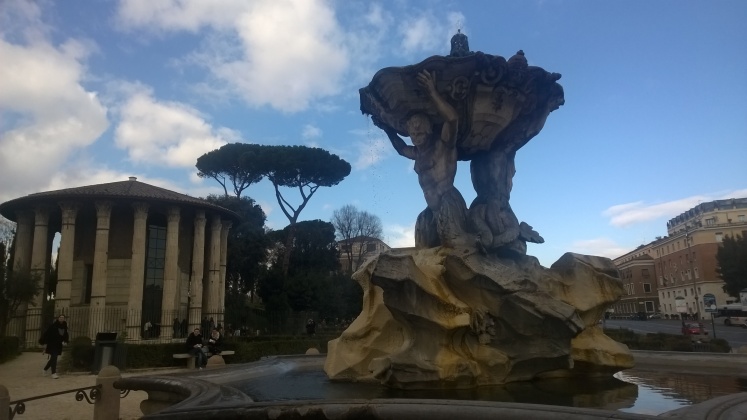Just a short walk away from Rome’s bustling Piazza Venezia lies one of the most interesting parts of the city: the Forum Boarium. In this area, the site of ancient Rome’s cattle market, you can admire two stunning temples dating from the first and second century BC, and uncover gems in several churches nearby.
I started my recent exploration of the Forum Boarium down by the temples, which are opposite the church of Saint Mary in Cosmedin, famous for the “Mouth of Truth” drain cover which tourists adore.
The oldest of the two temples dates back to the second century B.C. and was built to honour Hercules Victor, or Hercules Olivarius (of the Olive Merchants). This round temple was commissioned by a rich Roman merchant, Marcus Octavius Herennius, who dedicated it to Hercules in his role of protector of the olive growers, a group Herennius was part of. Hercules was also seen as the god of commerce and livestock movement, fitting with the temple’s position in the cattle market. Completely encircled by columns, it’s the oldest intact marble building in Rome:
The second temple is dedicated to Portunus, the ancient Roman God of keys, doors and livestock. Portunus’ association with gateways and doors also linked him to ports, and in ancient times this temple overlooked the Port Tiberinus on the Tiber river where cattle barges arrived in the city from Ostia.
The rectangular building, dating from the first century B.C. and fronted by four ionic columns, is striking and atmospheric. It is also relatively well-preserved after having been converted into a church over the years.
After seeing the two temples, I also visited the churches in the area. First of all I stopped at San Nicola in Carcere, just a short walk in the direction of the Capitoline hill. A church was first constructed on this site in the sixth century AD from the ruins of temples in the old Forum Holitorium, or vegetable sellers’ market, which used to be located here. You can still see the columns from the Temple of Speranza (goddess of hope) embedded in one of its walls, and ruins of other temples can be found underneath the church.
Inside there is an interesting 10th century inscription on a column near the door, which seems to be related to an offering of livestock and other gifts to the church.
Another church worth visiting in the area is San Giorgio in Velabro, or Velabrum, which refers to the low valley that connected the Roman forum to the cattle market. According to legends it is in this area that a fig tree stopped the basket carrying the twins of Rome’s foundation myth Romulus and Remus as it floated along the Tiber, thanks to the intercession of the River God Tiberinus. The twins were then found and suckled by the famous she-wolf.
Outside the church, close to the large fourth century Arch of Janus, I came across the Arcus Argentariorum. This is a white marble arch built by the money lenders (argentari) and cattle dealers of Rome in the third century AD, and dedicated to Emperor Septimius Severius. It is decorated with sacrificial scenes showing Severius with his wife (in the picture below) and his son, Emperor Caracalla with family members. Popular legends claimed that treasure was hidden within the arch, which led many treasure hunters to drill holes in it which can still be seen today.
The church next door was built in the seventh century and initially dedicated to Saint Sebastian. But during the rule of Greek pope Zachary in the eighth century, it was dedicated to Saint George, the Christian martyr killed in Cappadocia, and relics of his head are kept under the altar.
During my walk I also popped into the church of Saint Mary of Cosmedin, which was built during the Byzantine era of the papacy, over the remains of a temple and food distribution centre of ancient Rome. In the seventh century it was known as the Schola Graeca and it was decorated beautifully by Greek monks escaping iconoclastic persecution. As I visited in February, I was particularly interested to note that the church is home to the alleged skull of Saint Valentine.
Then I wandered up to the nearby Circo Massimo and had lunch in the Campagna Amica food market on Via San Teodoro, where I also browsed the many delicious products, including sauces, meats, olive oil, and cheese. Looking around the stalls reminded me once again about the area’s historic link to food, markets, trade and distribution. It’s open every weekend so you should try it too! Enjoy darlings!
For more information on the Campagna Amica market see here











“How very happy I am here in Rome when I think of the bad days
Far back there in the north, wrapped in a grayish light.
Over my head there the heavens weighed down so dismal and gloomy;
Colorless, formless, that world round this exhausted man lay.
Seeking myself in myself, an unsatisfied spirit, I brooded,
Spying out pathways dark, lost in dreary reflection.
Here in an ather more clear now a luster encircles my forehead.
Phoebus the god evokes forms, clear are his colors by day.
Bright with the stars comes the evening, ringing with songs that are tender,
And the glow of the moon, brighter than northern sun.
What blessedness mortals may know! Am I now dreaming? Or welcomes
Jupiter, Father, as guest—me, to ambrosial halls…?”